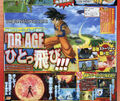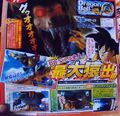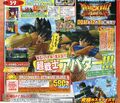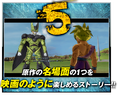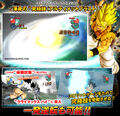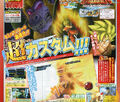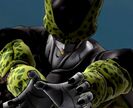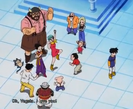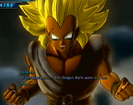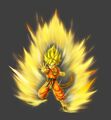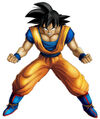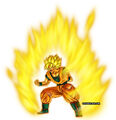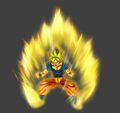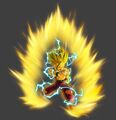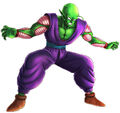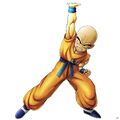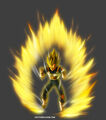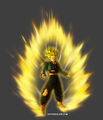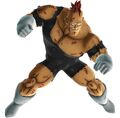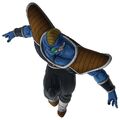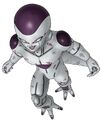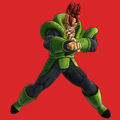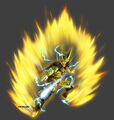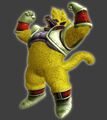Dragon Ball Z: Ultimate Tenkaichi, known as Dragon Ball: Ultimate Blast (ドラゴンボール アルティメットブラスト Doragon Bōru Arutimetto Burasuto) in Japan, is a fighting video game released by Bandai Namco for PlayStation 3 and Xbox 360. The game was announced by Weekly Shōnen Jump under the code name Dragon Ball Game Project: Age 2011. Internauts could vote for the name of the game, having the choice between: Dragon Ball Z: Tenkaichi Z, Dragon Ball Z: Saiyan Rising, Dragon Ball Z: Awakening Saiyans, Dragon Ball Z: Ultimate Tenkaichi, and Dragon Ball Z: Saiyan Warriors in Europe and North America. The title Dragon Ball Z: Ultimate Tenkaichi was eventually chosen and officially revealed on June 30, 2011.
Gameplay[]

Gameplay
Dragon Ball Z: Ultimate Tenkaichi dives into the Dragon Ball universe with brand new content and gameplay, and a comprehensive character line up. It has faithful manga-style graphics, totally destructible battle fields, and refined controls designed to bring the experience closer to the highly acclaimed Budokai Tenkaichi series.
The character and environment graphics are upgraded since the previous games; characters are drawn straight from the original series and to match the anime and makes it a true Dragon Ball experience. The game features the original Japanese voices and music, such as Cha-La Head-Cha-La.
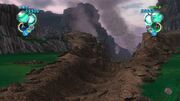
Environment destruction
“Impact Break” system allows large scale environment destruction. This includes realistic craters and Kamehameha tracers cutting across the sky, delivering a heightened sensation of realism and dynamic immediacy.
The controls are designed to bring the experience closer to the previous Budokai Tenkaichi series, making the play accessible to all, but retaining all the tactical depth in battle. Improved mechanics allow for faster long-to-short range fights. The gameplay also includes elements from the Budokai series, such as Quick Time Events during certain combos. There is also an added health recovery system and a vast collection of more cinematic camera angles. When a character has low health, their taunt will become one of the Blast 1 they used in the Tenkaichi games; for example, when at low health, base form Goku will have his taunt become Give Me Energy!
Modes[]
Story Mode[]
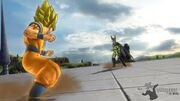
Super Saiyan Goku vs. Perfect Cell
The enhanced Story Mode immerses players in the Dragon Ball universe, and included bonus levels from the Dragon Ball Z movies and even one level from the Dragon Ball GT series. It includes Free-Roam style gameplay similar to the Story Mode of Dragon Ball Z: Budokai 3 and Dragon Ball Z: Budokai Tenkaichi 2. Fifteen animated scenes with bosses are included. Great Apes and other giant characters, such as Janemba (First Form) and Hirudegarn, up to 15x the size of playable characters are featured in boss fights and/or cinematics. The story mode also features digitally remastered scenes from the anime, making it more true to the Dragon Ball series.
The Story Mode begins with a battle between Bardock and Frieza, then the battle against Raditz and ends with the final fight between Super Saiyan 4 Gogeta and Omega Shenron. During Free Roam (if playing as Goku), Goku can ride the Nimbus Cloud or have another character such as Piccolo follow Goku. There are also Chase Sequences found in such instances as a battle between Vegeta and Zarbon. This includes a chase where the controlled character must escape Zarbon without getting too close or risk being defeated, as most villains will not hesitate to fire Ki Blasts if the controlled character fall behind.
After finishing the battle between Bardock and Frieza, and getting hit by Frieza's Supernova technique, a cutscene ensues showing the destruction of Planet Vegeta and Goku's arrival on Earth. After the cutscene, it shows flashbacks of Goku and Gohan at the Kame House, Goku taking the powerful blow to the stomach by Raditz, as well as Goku atop the Nimbus Cloud flying alongside Piccolo. The Free Roam screen includes a Dragon Radar used for finding such places as the Story Objectives or the World Tournament, however, if visiting the World Tournament during Story Mode, the player will be forced to use the character they are currently playing as in Story Mode. The screen also includes use of capsules, a recharge button and a full screen Dragon Radar. Also, certain characters equipped with scouters may use them as well. This interface is almost no different aside from giving the screen a red tint and including arrows that appear to guide towards the next Story Objective. The player also has the option to locate the Story Objectives or rather, can hide it and attempt to find it on their own: objectives have a large beam of light that shoots up from the ground, making them easy to spot at close range. When the controlled character reach the Story Objectives, a battle usually begins. Fight Sequences are far more accurate than those found the previous installments; for example, rather than having to do a Team Super Attack to kill Raditz with a Special Beam Cannon, Goku automatically holds Raditz while Piccolo launches it and destroys them both. This same effect can be seen when defeating Vegeta (Scouter) and executing the Spirit Bomb (or Fusion Spirit Bomb, as it was called in Dragon Ball: Raging Blast 2) when used as a Team Super Attack.
After a battle, a cutscene will ensue, followed by a narration telling the events that have taken place since that battle has taken place. After this, the controlled character will return to the Free Roam screen and be free to travel to the next Story Objective. Also, several Story Objectives contain Boss Battles, which often take place after defeating certain enemies to a point, such as Vegeta (Scouter). After his apparent defeat, he transforms into a Great Ape. Most bosses can be defeated easily by either punching them or firing Ki Blasts at them. After this they can be taken down easily, often with only a few button combinations.
Hero Mode[]
Ultimate Tenkaichi includes a special mode, called "Hero Mode", which allows the player to experience a whole different story of Dragon Ball Z. A "Complete Character Creation & Customization"[1] feature was confirmed on July 2011 by Bandai Namco Games. Appearance and attributes can be customized such as model body, face, hair, attire, type of voice the character will have, and fighting style. Additionally fighting style and special moves can be selected. The created characters can roam the world, battle various enemies from the series and share their characters online. Only male Saiyan characters can be made.

The free-roam type of gameplay
The Hero Mode includes its own story with missions similar to that of the story mode, but without anime cutscenes. While training around the world, the hero meets and fights Captain Ginyu, who gives him a Dragon Ball. Later, the hero hears of Android 17 and Android 18, he fights them in a city and learns that they possess two Dragon Balls and the Dragon Radar. He spares them after the battle and obtains the Dragon Radar and their two Dragon Balls. During his journey, the signals on the radar disappear. The hero hears of Piccolo, the reincarnation of King Piccolo, and tries to find out if he is behind the recent disasters on Earth. He fights Piccolo on the glacier, and transforms into a Super Saiyan during the battle. He then learns that Piccolo was looking for the one responsible for the chaos too. Piccolo tells him that someone gathered the seven Dragon Balls a year ago and wished Ultimate Shenron to make Earth a living Hell. When he was about to confront this person, Piccolo was attacked and injured by a Great Ape. Then, Piccolo offers to train the young hero. After this, the hero finds the Great Ape who injured Piccolo, Golden Great Ape Baby, in a city. He defeats him and learns that the person he is looking for is Omega Shenron. He goes where the Dragon Radar displays the location of three Dragon Balls, and finds Omega Shenron. After being defeated by Omega Shenron, and having his Dragon Balls stolen and scattered, the hero must gather six Dragon Balls by battling various characters, and then he must defeat Omega Shenron for the seventh Dragon Ball. On The Lookout, the hero finds Ultimate Shenron controlled by Omega Shenron's negative energy. The eternal dragon attacks the hero while he was trying to make a wish. Once defeated, Ultimate Shenron grants the hero's wish to bring back all those who were killed by the chaos Omega Shenron created. The world is still in darkness, but the ray of light has not been defeated as the young hero sets out to save the world with his own hands.
Timeline placement[]
Piccolo mentions in the story mode that Goku and Gohan are no longer around, showing that it takes place a long time after Dragon Ball GT. Additionally, the Dragon Balls have returned to the world, an event which happens around Age 889, so the story takes place around Age 889, after Dragon Ball Heroes: Victory Mission and presumably Dragon Ball GT: A Hero's Legacy.
Tournament Mode[]

An example of the Tournament registry
Like many games before it, Dragon Ball Z: Ultimate Tenkaichi features a World Martial Arts Tournament mode where up to 16 characters can be registered in a tournament. The difficulty can be changed.
It is almost identical to previous installments, aside from the fact that the player can use custom characters to compete. This mode also includes the Stage Destruction, however it is not as in-depth and realistic as the Story, Hero, or Battle Modes.
Characters[]
Playable characters[]
| Name | Playable Transformations | Available at Start |
|---|---|---|
| Android #16 | Yes | |
| Android #17 | Yes | |
| Android #18 | Yes | |
| Android #19 | Yes | |
| Android #20 | Yes | |
| Bardock | No | |
| Broly |
|
No |
| Burter | Yes | |
| Captain Ginyu |
|
No |
| Cell |
|
Yes |
| Cell Jr. | Yes | |
| Cui | Yes | |
| Dodoria | Yes | |
| Frieza |
|
No |
| Gogeta |
|
Yes |
| Super Gogeta |
|
No |
| Goku | Yes | |
| Gotenks |
|
Yes |
| Janemba |
|
No |
| Jeice | No | |
| Kid Buu | Yes | |
| Kid Gohan | Yes | |
| Krillin | Yes | |
| Majin Buu | Yes | |
| Majin Vegeta | No | |
| Nappa | Yes | |
| Omega Shenron | No | |
| Piccolo | Yes | |
| Raditz | No | |
| Recoome | Yes | |
| Saibaman | Yes | |
| Super Buu |
|
Yes |
| Teen Gohan |
|
Yes |
| Tien | Yes | |
| Trunks |
|
No |
| Ultimate Gohan | Yes | |
| Vegeta |
|
Yes |
| Vegeta (Scouter) | No | |
| Vegito |
|
No |
| Yamcha | Yes | |
| Zarbon |
|
Yes |
| Custom Hero |
|
Yes |
Giant bosses[]
Story Mode[]
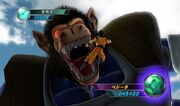
Boss fight against Great Ape Vegeta
- Great Ape Vegeta
- Metal Cooler (Nucleus)
- Janemba (First Form)
- Hirudegarn (Final Form)[2]
Hero Mode[]
Battle Stages[]
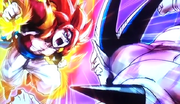
Super Saiyan 4 Gogeta vs Omega Shenron in the intro for the game
- Wasteland
- Rocky Area
- Planet Namek
- Ruined Planet Namek
- Ruined City
- Island
- Glacier
- Cell Games Arena
- Hell
- Supreme Kai's World
- Cave
- World Martial Arts Tournament
- Temple
- Dark Planet
- Big Gete Star (Story mode only)
Reception[]
| Publication | Score | |
|---|---|---|
| IGN | 7.5 of 10 | |
| Gamefocus | 6.0 of 10 | |
| GameSpot | 4.0 of 10 | |
| Review compilations | ||
| Game Rankings | 56.8% (based on 15 reviews) | |
| Metacritic | 58% (based on 26 reviews) | |
The game has received mixed responses. The Japanese magazine Famitsu gave 31/40 to the game, Gaming website IGN rates the game a 7.5 out of 10, with other popular gaming website GameSpot gave the game a 4 out of 10, stating the game is far too simplistic, with the game having no substance, calling the gameplay shallow. Metacritic rates the game 55 for the Xbox-360 version, while the PS3 version received a 58.
The game sold 700,000 copies worldwide on PS3 and Xbox 360 by March 2012.[3]
Trivia[]
- Some of the in-game cutscenes were recycled from Dragon Ball: Raging Blast, making it a mix between the original Dragon Ball Z dub and the Dragon Ball Z Kai dub, with the new voices and old voices of certain characters swapping around once in a while.
- Character models from Ultimate Tenkaichi are recycled in Dragon Ball Z For Kinect.
- Kid Gohan's 1st and 2nd costumes have his waist stripe colored blue like in the manga.
- Super Saiyan 4 Gogeta's second "color" turns his hair gray which looks similar to the fan-made Super Saiyan 5.
- Two of the background music tracks in the game are called Heat Capacity and Edge of Spirit, both names were already used for earlier background music in Dragon Ball Z: Budokai Tenkaichi 3.
- Many Super Attacks available for a custom character to use are attacks from characters who do not even appear as playable characters in the game, such as Nail's Mystic Flasher, Android 13's Full Power S.S. Deadly Bomber, Cooler's Death Chaser and Future Gohan's Fierce Combination.
- Teen Gohan's English voice actress is not listed in the credits sequence.
- Great Ape Baby is erroneously credited to Vic Mignogna.
- Like in other video games, Semi Perfect Cell's voice is the same as his Perfect Form's when he charges up.
- In Battle Mode if you pair up Super Vegeta with Cui, Cui will say "Impossible! Vegeta transformed!" as if he already knew about the Super Saiyan transformation.
- Ironically, both in Dragon Ball Z: Ultimate Tenkaichi and Dragon Ball Xenoverse, when both custom characters met Captain Ginyu and were offered positions in the Ginyu Force if they met the certain requirements, both Characters turned it down after completing the requirements.
- In the opening sequence, Vegeta is seen wearing his outfit in the Buu Saga, but wears a Battle Armor in the scene after Goku defeats Hirudegarn.
Gallery[]
- Promotional material
- Screenshots
Yamcha faces Goku |
- Characters
References[]
External links[]
- Dragon Ball: Ultimate Blast official website (Japanese)
- Dragon Ball Z: Ultimate Tenkaichi official website (English)
- Dragon Ball Z: Ultimate Tenkaichi overview at namcobandaigames.com (English)
- Gamespot review of Dragon Ball Z: Ultimate Tenkaichi












